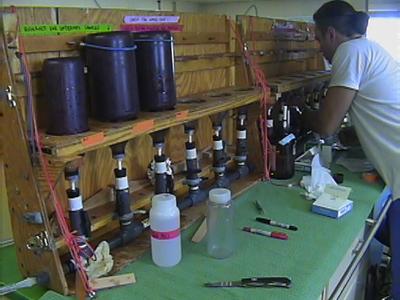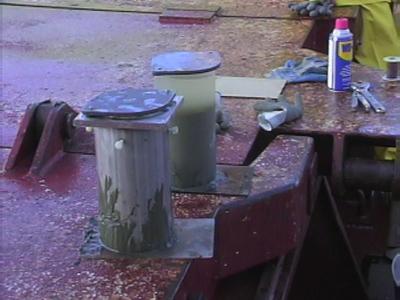16 July, 2003
Science at Full
Throttle
Its interesting to me that after such a short time at sea how the days
have all melted together and all concept of time revolves around have many
hours to the next station and not by the time on my wristwatch. Day versus
night has no more meaning to me and I find myself conceptualizing the time
by one of two things, is there a meal being served (which means its either 6
AM, 11:30 AM or 5:00 PM) or new crew faces indicating crew work shift change
from day to night.
A couple of other interesting observations have also enlightened me on
my salty excursion, one of which is sense of balance. You know those
carnival funhouses that have the room with the floor that gently tilts and
rocks back and forth? I could never walk through those without getting a
minor concussion. Well working aboard ship is similar, every room, floor,
and wall gently rocks with the swells and waves of the sea back and forth,
back and forth, up and down. By all rights I should have multiple skull
fractures by now or at least bruises. The Laurier rides very well and after
a short time I've adapted. I can climb rocking stairwells with ease,
traverse swaying hallways, remaining unscathed, able to scramble down a rope
ladder over the side of the ship effortlessly (nearly) Its a bird! It's a
plane! NO it's TEA Dave! (Sorry I couldn't resist).
Well enough about my enlightenment and back to what we have been doing
over the past two days.
Tuesday the 15th I awoke to the rare pleasure of being able to view the
United States (St. Lawrence Island) and Russia (Siberia) at the same time.
And although the weather started out fairly hazy with a chilly and misty
breeze it progressively turned better.
Our first station of the day called for only a CTD deployment (I took
advantage of this time to catch up on some much needed sleep) then eight
hours before our next series of stations and science at full throttle.
We arrived on our first of four stations, located at latitude North
64.667 degrees and longitude West - 169.922 degrees, a little after dinner.
The water depth here was a mere 47 meters. Each of the four stations
required a CTD, HAPS corer and van Veen grab deployment. Each station was
approximately two hours apart so a schedule of work for two hours rest for
two carried on throughout the night.
For three out of four of the stations throughout the night is was sunny
and beautiful. We arrived at the fourth station at 5:00 AM. It's interesting
that I don't even set my watch anymore between stations I just sleep until I
hear the engines slow down and then stop. (I wish getting up to teach were
as easy) Our fourth station was located at latitude North 64.992 degrees and
longitude West -169.135 where it was cold, windy and raining. With
methodical precision we finished around 7:00 and had several hours before
our next flurry of stations.
Killer whales off the starboard bow came the announcement mid day over
the intercom and naturally I rushed to the upper deck to see. The pod came
relatively close to the ship and swam southward. A few more were later
sighted off in the distance. Throughout the rest of the day several more
whales were sighted, probably gray whales, on both sides of the ship, too
far for photos. Geysers of seawater blew into the air as the whales
surfaced. At times there were so many geysers spewing into the air it
appeared like the calliope of a Mississippi River steamboat playing a
forgotten melody.
By early Wednesday of the 16th it was becoming obvious that the lack of
sleep was beginning to take its toll. Five consecutive CTD deployments with
about 30-45 minutes between stations and many of us operating on only a few
hours of sleep over the past two days our endurance was about to be truly
tested. Giddiness and work games like ring 'round the CTD rosette as samples
were being drawn helped pass the time as the seven of us, encircled it drew
a sample stepped to the left, sample step sample step to each his/her own
mental music.
With all of the stations finally completed the Laurier set course for
Little Diomede Island. I'm anxious to return to Little Diomede to view its
true likeness without the ice and snowy shroud it wore in March/April

A washed sediment sample revealing benthic organisms.

Nathan filters chlrophyll samples from water just collect with CTD

Successful sediment cores from HAPS corer.
Contact the TEA in the field at
.
If you cannot connect through your browser, copy the
TEA's e-mail address in the "To:" line of
your favorite e-mail package.
|
